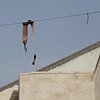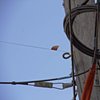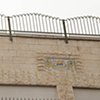
Urban Bricolage: The Eruv, 2010-2012
These photographs explore Jewish spatial practices through the concept of the eruv, or Sabbath border. An eruv enhances the Sabbath by facilitating carrying. Jewish law does not normally allow the carrying of objects in public spaces or between private and public spaces on the Sabbath, a prohibition based upon the biblical imperative to “do no work” on that day. This rule can make some simple activities complex. A visit to a synagogue, for example, could involve leaving one’s door unlocked or wearing the key as a decoration. To push a stroller, or a wheelchair, is proscribed. Children may not carry their toys outside to play. If, however, the inhabitants of private dwellings constructed around a common shared courtyard form a partnership allowing them to regard themselves as living together in one home, then during the Sabbath they may carry throughout the courtyard as if in their own homes. Both the proscription and its amelioration are Talmudic.
The photograph reveal the eruv as a work of architecture and urban planning whose program is the neighborhood, and whose materials are the appropriated accumulations of urban life. It is also a work of art whose simple line surrounds and defines the complexity of urban space while it defines the complex human community that inhabits its space.
The photograph reveal the eruv as a work of architecture and urban planning whose program is the neighborhood, and whose materials are the appropriated accumulations of urban life. It is also a work of art whose simple line surrounds and defines the complexity of urban space while it defines the complex human community that inhabits its space.









